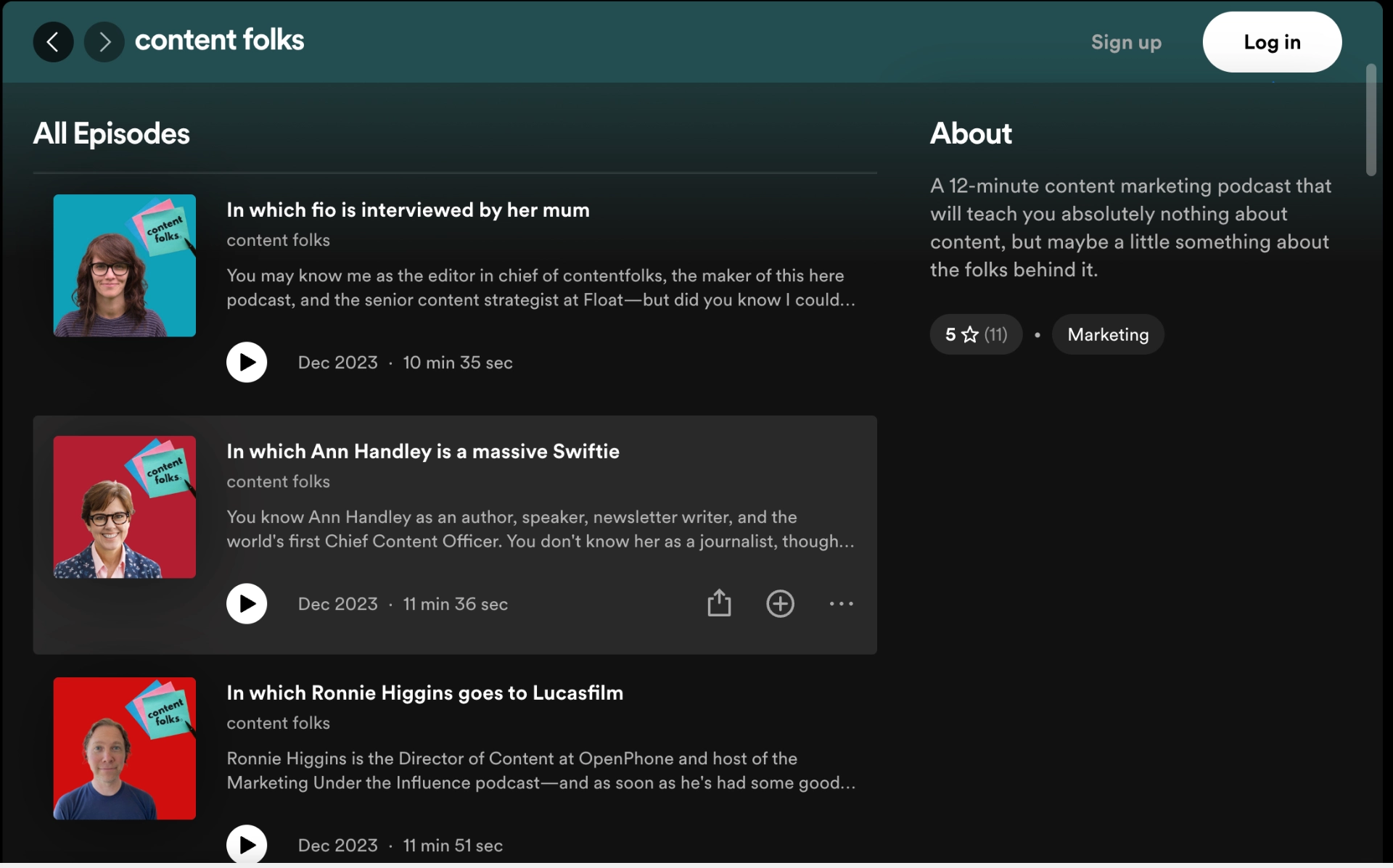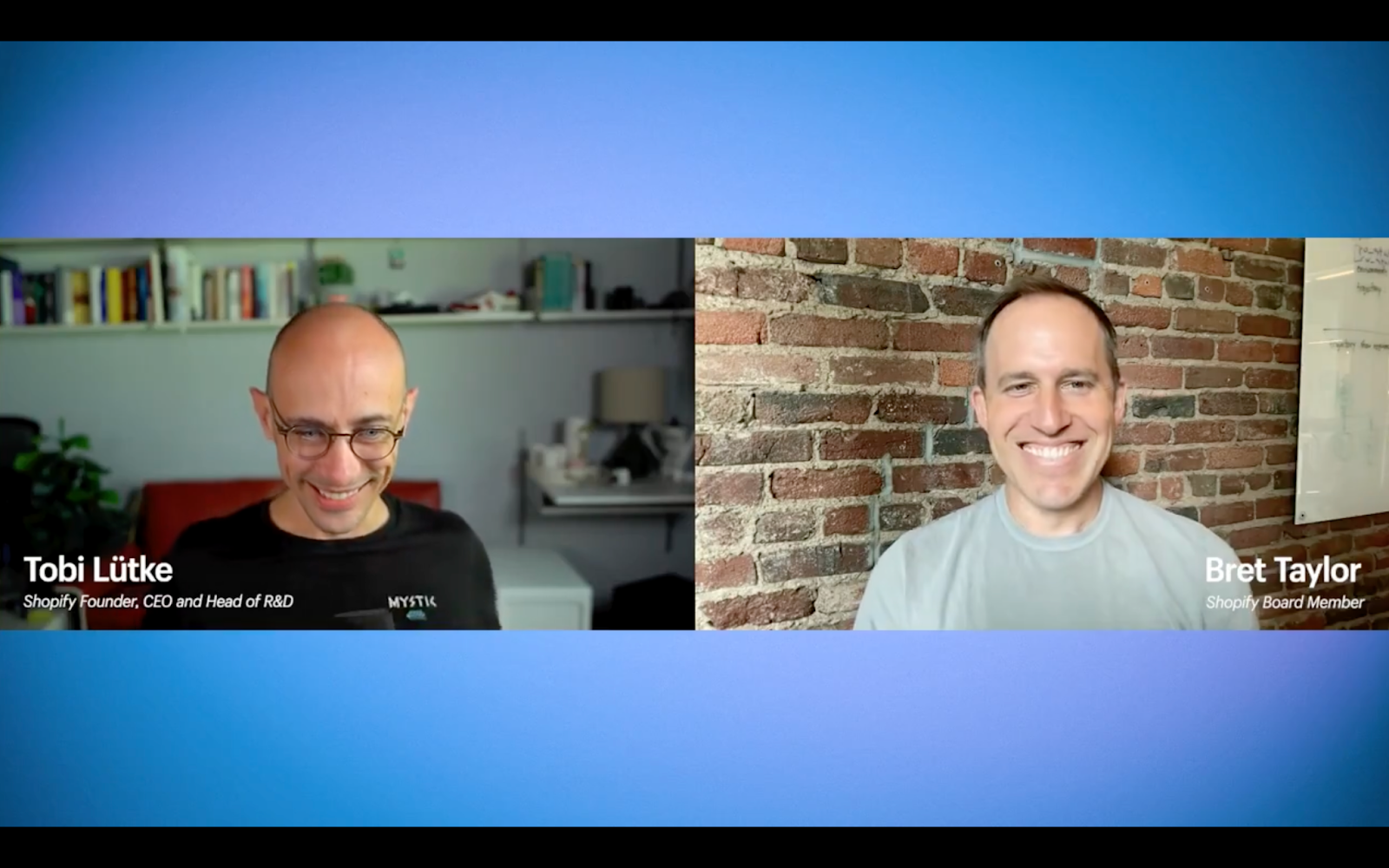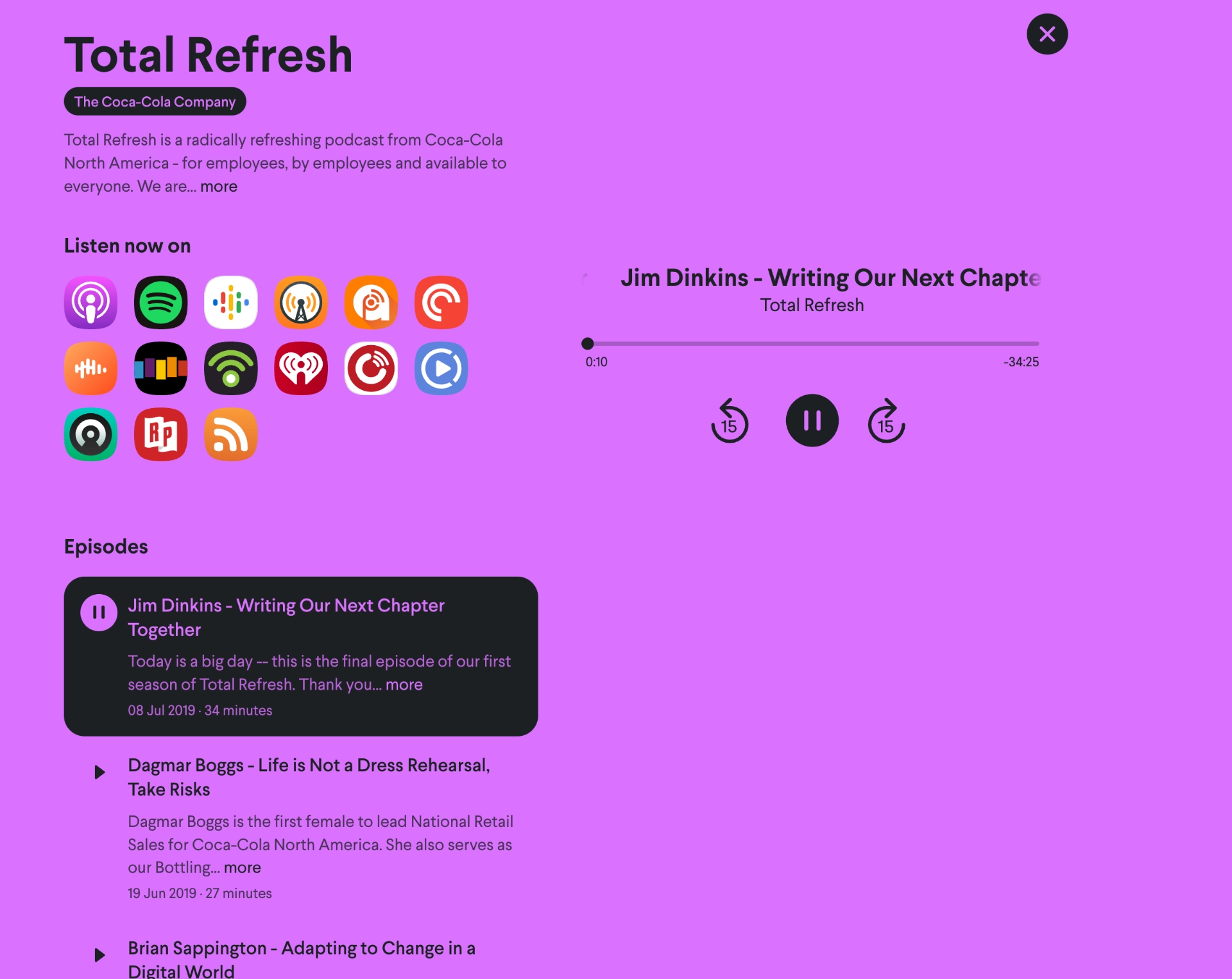An internal corporate podcast just for employees might seem excessive. It demands time and resources, has an inherently limited audience, and the returns are hard to measure. So why even bother?
The boost to company culture and employee morale is why—especially for the increasing number of organizations with distributed or remote teams, or those that lean into async communication.
The good news is that you don’t need a big production budget to host an internal podcast. It just needs to be enjoyable to consume and efficient to produce.
Start an internal company podcast
- What is an internal podcast?
- The benefits of starting an internal podcast
- How to create an internal podcast
- Examples of companies that produce internal podcasts
What is an internal podcast?
An internal podcast is audio or video programming designed specifically for employees—distributed exclusively within the organization. Sometimes called a “corporate podcast,” it can be an effective voice for the company to showcase its values and culture to employees. Unlike traditional company communication channels like emails or newsletters, a podcast is a dynamic medium that fosters dialogue. Plus, internal podcasts are easy to distribute through your existing internal communication channels and tools.
Internal podcasts are like your team’s virtual water cooler, but better. They offer a platform for anyone to share a story, a lesson, or an update. This could be your HR team focusing on culture initiatives, a project manager sharing insights from the latest sprint, or your founder introducing a board member.
Fio Dossetto, Senior Content Strategist at Float, says, “I believe our internal podcast accelerated a sense of closeness, community, and trust with folks I hadn’t (and still haven’t) met in person.”
This inspired her to create a similar podcast, called Content Folks, to get to know people in content marketing roles. The podcast followed the same format as Float's internal one with 12-minute episodes focused on people's lives outside their job.
 |
The benefits of starting an internal company podcast
Not only do internal podcasts let employees learn about their colleagues and founders, hear their stories, and get a peek into different departments—all the information is also recorded for easy consumption.
“Knowing I wouldn’t meet my team in person for at least a year, internal podcasts felt like an excellent way to give them a sense of who I was and what I cared about outside of the role I was taking at the company. And I think this sentiment was shared by everyone on the team. I also discovered a few deeply personal things about my manager that I doubt would have otherwise appeared in our 121 conversations during the following quarter.”
—Fio Dossetto, Senior Content Strategist at Float
Company podcasts help you:
- Perpetuate company culture and build a sense of community. Remote teams only meet via emails or video calls for job-specific assignments. This gives them little idea of their peers outside of work.
- Prepare for a company-wide meetup or event. For Romina Aranzola, Talent & Experience Coordinator at Float, an event triggered their internal podcast. They had a team meet-up in Japan, and she thought it would boost morale to get everyone acquainted beforehand.
- Improve communication and engagement within the organization. Once you’ve learned about someone virtually, it’s easier for you to talk to them in person. You can skip icebreakers or a getting-to-know-you period and start off on a more intimate note.
- Give leadership a direct line to employees. Podcasts let company leaders share regular, down-to-earth updates that resonate with younger or distributed teams seeking better access to executives.
- Record your company's history for future employees. An internal podcast acts as a time capsule that captures your company's culture, wins, challenges, and stories. It helps new hires learn nuances and cultural references that would otherwise trickle down slowly through word of mouth.
- Share information, news, and updates vs. synchronous all-hands meetings. An internal podcast offers flexibility and respects individual schedules and work styles, ensuring your employees receive important messages without disrupting their workflow. But you need to carefully preview podcasts to make sure outdated information isn’t passed around.
- Showcase expertise and knowledge within the company. An internal podcast celebrates employee contributions and turns each episode into a learning opportunity. This approach democratizes knowledge and helps the team—from interns to executives—to build a collective pool of wisdom.
- Provide a convenient and accessible format for learning and development. Romina chose the podcast format because it’s travel-friendly. “And it was a roaring success,” she says. “Everyone listened to the episodes while waiting in queues, at baggage claim, or on the plane—while traveling to the company meet-up.” We recommend creating a video podcast that can be turned into text and audio later on to accommodate multiple consumption styles.
All that said, not every employee will be open to sharing experiences in such a public format, nor will everyone tune in. An internal podcast is just one way to distribute information internally that should be complemented with other formats such as newsletters or Slack updates.
How to create a private internal podcast just for employees
Here’s a 6-step process you can use to start your own internal podcast at your company:
Step 1: plan your podcast
Launching and sustaining an internal podcast involves less organization than an externally distributed one. For one, everyone is working toward the same goal, so it’s easier to get participation. Second, since you have insight into team members’ jobs and responsibilities, you can strategically schedule your interviews. Third, you can use company meetups or team meetings as a topic bank.
Here are four best practices we recommend:
- Schedule key activities. Whether it's just you or a revolving team of twenty hosts, schedule regular appointments for brainstorming. This way, even when work piles up, your podcast project stays on course.
- Prioritize tasks with longer lead times. Interviews with the executive team take longer to schedule and complete than, say, picking a podcast hosting provider, so schedule your hard-to-nail-down guests first. In general, start with the tasks that tend to take the longest.
- Batch tasks for efficiency. Rather than piecemeal planning for each episode, think in terms of series or seasons. Group together activities like brainstorming topics, reaching out to internal teams, and conducting research. That way, you minimize the downtime between tasks.
- Streamline the review process. In teams with multiple review rounds, it's easy to get caught in a cycle of approvals. Establish a clear review protocol early on.
“Batch planning was critical for us as a small and distributed team. We sent out batch calendar links for specific weeks, recorded a season of episodes in one go, and released them in batches of 6–8 so people could binge-listen.”
—Romina Aranzola, Talent & Experience Coordinator at Float
Step 2: map out your time and resource constraints
Doing this early on ensures you can allocate your efforts wisely, focusing on your strengths while delegating other tasks. We also recommend sending out a quick survey to see if your workforce is interested in an internal podcast and what format they might prefer—that feedback can help shape your approach.
For example, Float outsourced podcast editing to avoid getting bogged down by bottlenecks—they could record while a third party edited.
Many internal podcasters also choose to use solutions like Descript to make it easy for a single person to record, edit, and host their own in-house podcast.
When you understand your constraints, you'll be better equipped to recognize what type of podcast you can produce. Here are 7 key considerations for starting a podcast:
- Premise: This is the core idea or theme of the podcast. Align this with your objectives and the interests of your target audience. You could include industry insights, company news, employee achievements, or professional development topics.
- Format: This is the structure of the podcast episodes. Options include solo commentary, cohosted discussions, interviews with company leaders and external experts, and panel discussions.
- Guests: Your guests could range from C-suite executives to new hires or even external experts, depending on your premise.
- Frequency: This is how often you release new episodes. The frequency should balance the team's capacity to produce quality content and the audience's appetite for new episodes. Float recorded all of their episodes in one session and released 7–8 episodes a week until the team meetup.
- Duration: This is the length of each episode. You can have shorter episodes for getting-to-know-people segments and longer episodes for expert discussions. Float had 12-15 minute episodes so people could fit them into their travel schedules.
- Channels: The platforms and methods used to distribute the podcast. Your options are the company intranet, email newsletters, or a dedicated internal podcasting app. The closer this channel is to employees’ everyday activities, the higher their chances of tuning in. Slack or team workspaces in Notion work well.
- Accessibility: If you're doing audio-only podcasts for a large organization (over 1,000 employees), consider adding transcripts. While podcasts aren’t strictly regulated yet, internal communications need to be accessible to all relevant employees—including those with audio processing disabilities.
Romina decided on a guest cycle alternating between old and new hires, men and women, and managers and coordinators to keep things interesting. “The emphasis was on maintaining diversity and quality so that everyone felt represented and heard,” she says.
“We set it up round-robin and send out calendar links for people to book the time to chat. On the booking page, we also had the questions and premise, so information was accessible and our guests were ready to go. In total, we didn’t want them to spend over 30 minutes,” she added.
3. pick a host
Choose a host who communicates frequently with every team. Ideally, this is someone in the organization's People or Culture function, but it can also be a dedicated internal communications coordinator or a cross-functional project manager.
At Float, Romina hosts the podcast with Jasmin Mayfield, UX Researcher.
You could even cycle through employees to host, or ask mid-level employees to interview senior leadership.
4. gather your recording gear
Starting your internal podcast doesn't require a professional studio or breaking the bank. With some basic, budget-friendly equipment, you can produce content that sounds great. Here’s what you’ll need:
- Camera: If you plan to record a video podcast, a good quality webcam or a smartphone with a decent camera can do the trick. No matter what device you choose, consider setting up lighting and using a consistent background for a polished look.
- Microphone: Sound quality is critical. Thankfully, you don’t need an expensive mic to start. Look for a USB microphone that you can directly plug into your computer, and test it beforehand for audio clarity. The team at Float recorded their podcast with their headphone mics and the audio held up.
- Recording method: Consider an application that allows for multi-track recording so you can have separate audio tracks for you and your guests. That way, you have more control over editing.
- Editing software: With Descript, you can create a great podcast on a budget with virtually zero experience. Its transcript-based editor makes podcast editing as easy as editing a doc, and it also offers features like Studio Sound to produce studio-quality audio regardless of your microphone.
5. record your podcast
You could start with recording a Zoom call, but that's not the best approach for quality or efficiency. Starting out with a dedicated tool helps you streamline every step of the process early on.
Descript includes a built-in remote recording studio for up to 10 guests, making it easy to schedule and record remote interviews 1:1 or with a panel. Then you can jump right into editing, or pass the footage on to someone else on the team.
6. publish and distribute your internal podcast
Before you hit publish, make sure that you’ve taken all possible precautions to keep your podcast private and secure. Restrict access to employees only—carefully considering privacy and consent. Accidentally sharing personal stories and customer news externally without explicit permission can breach trust and confidentiality. Also consider how you’ll measure engagement—track listens or downloads, gather employee feedback, and periodically gauge how well the podcast meets its goals. Doing so ensures your content remains relevant and valuable.
John Ferry is the CEO of UseRogue where he develops multiple internal podcasts for the government. "It's crucial to deploy the content on internal infrastructures to keep it secure," John said.
You can use a podcast hosting platforms that support private podcasts like:
- Podbean
- Transistor
- Castos
These platforms give you control over and visibility into who listens to your podcasts.
Check your chosen platform for security features such as encryption, password protection, and controlled access through secure RSS feeds. Privacy controls ensure that you can regulate your company narrative and protect your competitive advantages.
Then, promote and distribute your podcast through secure tools only employees can access, like Notion, Slack, or Descript.
“Every Friday, Romina would announce a batch of new episodes on Slack, and the team would comment, react, and celebrate one another. The engagement rate was over 80%,” says Fio.
Examples of companies with internal podcasts
Here are a few real-world success stories from companies that made internal podcasts more than just another broadcast channel—they used them to connect, educate, and spark conversation.
Float
Float created an internal podcast to bolster its culture-based initiatives.
They opted for questions like:
- What topic could you give an hour-long presentation on without preparation?
- Describe a time when you changed your mind?
- What’s your idea of happiness?
 |
Shopify
Shopify has an internal podcast to make thoughts and insights from founders and board members accessible to internal members. Their podcast follows a more organic format—think coffee chat versus an interview. Here’s a look at some of their questions:
- Can you talk about your career history and trajectory? Connect the dots between your roles at Google, Salesforce, and Twitter.
- In the '80s and '90s, we saw a huge change in computing where everyone did everything, and people were interviewing for roles that were different from what they studied. What do you think about that?
 |
Total Refresh by Coca-Cola
Total Refresh is hosted by Katherine Cherry and Jamal Booker, who create conversations around navigating a new spectrum of different beverages at Coca-Cola, from sparkling drinks to coffee, juices, and waters.
In each episode, they sit down with a leader from Coca-Cola North America to understand how they will shift to a total beverage strategy and how each leader sees their role and the role of the employees.
What makes this one special is how it started out as an internal company podcast but was made available to the general public after.
"I always encourage our clients to make their employee podcasts available externally," said Michelle Khouri, CEO and founder of FRQNCY Media, the company that produced Total Refresh. "That's when you can see the halo effect of a well-made podcast extend to positively impact the company's talent acquisition goals and how the brand is perceived among non-employee audiences."
 |
Starting an internal podcast is easier than you think
Internal podcasts can be a heavy lift if you don’t have the right resources. They rely on smart planning, consistent production, and the right tech setup.
But with a plan, a few clever shortcuts, and secure internal infrastructure, they’re an easy way to connect people—and showcase your company’s culture and narrative.
Internal podcast FAQs
What is the purpose of an internal podcast?
An internal podcast improves organizational communication and culture within a company, and helps employees feel connected to each other across departments.
How are podcasts used internally in an organization?
Organizations use podcasts internally to share updates, insights, and ideas. They can be a virtual meet-up with multiple members or a 1:1 getting-to-know-you session.
What is a corporate podcast?
A corporate podcast acts as a voice for the company to deliver content that aligns with its values and goals. It's an effective way to engage employees, share success stories, and enhance corporate culture.
Frequently asked questions
What is the difference between an internal and an external podcast?
An internal podcast is shared only with people inside an organization, while an external podcast is publicly available to anyone. Internal podcasts focus on company news and employee engagement, and external podcasts are typically aimed at a broader audience or customers.
How do I keep an internal podcast private?
You can make your internal podcast private by using secure hosting platforms and limiting access to employees only. Examples include private RSS feeds requiring logins or invite-only web portals that restrict who can listen.
How do I measure success for an internal podcast?
Track metrics like episode downloads, average listening time, and feedback from listeners to see what's working. You can also measure employee engagement by looking at comments and discussions sparked by each episode.































%20(1).JPG)








